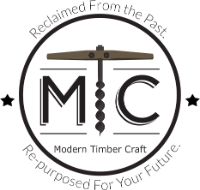While there are a lot of options when it comes to materials for your wall, using reclaimed wood comes with many benefits. For example, the unique appearance of the wood itself, which is impossible to recreate, and the environmental benefits of repurposing wood that would otherwise end up in a landfill.
Reclaimed wood can be used to cover many wall spaces, including recreation room walls, backsplashes, kitchen islands, and more. If you have a large room, covering a single wall (an accent wall) in reclaimed wood panels can add character and depth to the space.
When it comes to the species of wood to use, the look and durability of oak makes it one of the most popular choices today.
Let’s dive into what you need to install a reclaimed wood wall.
Tools & Materials
Materials
- Your choice of reclaimed wood planks
- (Optional) Paint or felt paper to cover the underlying surface
Necessary Tools
- Nail Gun or Hammer – For securing your planks to the chosen wall or surface
- Brad Nails or Finishing Nails – Brad nails are recommended for their smaller diameter and minimal appearance
- Hand Saw or Electric Saw – Used to trim/shape your planks for a proper clean fit
- Pencil – For marking your planks prior to cutting
- Tape Measure – To measure the wall or surface and planks
- Level – For ensuring your planks are installed straight across the wall or surface
Recommended Tools
- Laser Level – A laser level will help simplify the process of ensuring your planks are installed straight
- Jig Saw – Using a jig saw will greatly speed up the trimming and shaping of your planks prior to installing
- Brad Nail Gun – Using a nail gun designed for brad nails will decrease the odds of having nails jam or misfire
- Caulking Gun – (Optional) A caulking gun makes adding adhesive simple
- Construction Adhesive – (Optional) Adhesive helps to ensure your planks sit level on the wall/surface and adds to the strength of your installation
Safety Gear
- Gloves
- Safety Goggles
- Ear Plugs
- Dust Mask
Preparation
After you’ve sourced and acquired the reclaimed wood for your wall, preparing the wood for installation is a necessary step to ensure proper fit and a clean look.
While it is rare to receive bug infested reclaimed wood from a reputable seller, it is always best practice to inspect your wood. These signs can include discarded wings stuck to the wood and small holes about the size of a pencil throughout the wood. Even check for or visible insects present on the wood. Kiln-dried reclaimed wood is typically bug free, but the process adds a premium when it comes to cost.
Once you’ve ensured your reclaimed wood is free of infestation, selecting the best planks for your project is next. You’ll want to select the right combination of planks for a proper fit. Mix and match colors to find the desired look. Lay your reclaimed wood planks out on the floor to mimic the wall arrangement. By doing this, you can see how your selected planks will fit together when your project is done.
Installation
Now it’s time to being installation. Here we have the step-by-step process of installing your planks to ensure your project is a success.
Step 1
- Begin with cleaning and measuring the surface to be covered.
- Optionally, you may wish to paint the wall/surface to be covered to match the color of the reclaimed wood you’re using; in case of any holes or gaps in the wood that show the underlying surface.
- Another option to mask the underlying surface is to use black felt paper or tar paper to cover your wall/surface prior to installation of your wood.
Step 2
- Using your level and pencil, make a reference line from one end to the other along the top or base of the wall. Double check to ensure your line is level! You may also choose to use an existing straight edge, such as the ceiling or floor.
Step 3
- If you use construction adhesive, apply in a wave pattern to the back of your desired plank; being sure to not apply too close to the edge to avoid adhesive seeping out beyond the plank.
- Using your reference line or your desired straight edge, firmly apply the plank to the wall.
- Secure the plank by applying nails to each corner of the plank, about 1/2 inch from the edges.
Step 4
- Once your first plank is in place, repeat step 3 and work outward toward the opposite edge of the wall installing boards in a staggered fashion to avoid large seams.
- When you reach the end of a row, measure the final space to be covered and cut a plank to fit.
- Repeat these steps for each subsequent row until you have completely covered your desired surface.
The unique appearance and character found in reclaimed wood is impossible to replicate, adding value to your space. The ease of installing a reclaimed wood accent wall or full wall makes it a simple way to redesign any space. Once you complete your accent or full wall covering, the aesthetics and depth added to your space will have you falling in love with the results every day.

Written by Jake Park
Jake is the founder of Modern Timber Craft and is a seasoned reclaimed woodworking enthusiast with over 20 years experience.


